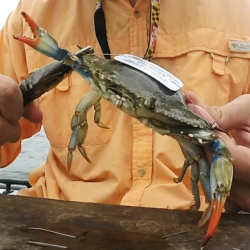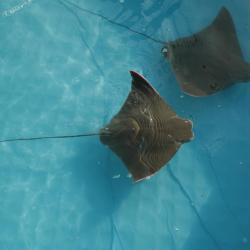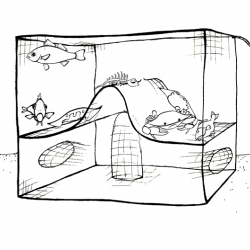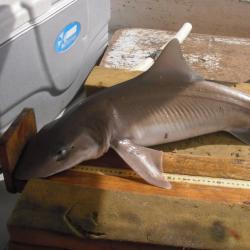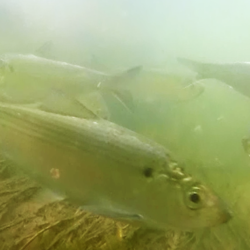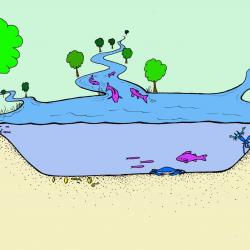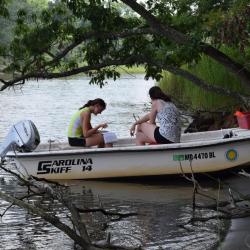The Fisheries Conservation Lab investigates the ecology, management, and conservation of marine and estuarine fisheries. We depend on fisheries for many things including food, employment, recreational opportunities, and culture, but fishing and aquaculture rank among the greatest human impacts on marine ecosystems. Finding a balance between harvest and conservation of fishery species and mitigating the impacts of fisheries on marine ecosystems will be key to sustaining productive, resilient coastal and marine ecosystems for future generations.
Our interdisciplinary research focuses on providing the best scientific information available to inform fisheries management and conservation decision-making at scales from local communities to global institutions. We apply field and laboratory studies, emerging technologies, models, and historical perspectives across four research themes: 1) fisheries science, 2) movement ecology, 3) ecological restoration, and 4) long-term dynamics of coastal ecosystems.
Job posting: Animal Telemetry Postdoctoral Fellow
Posted by Matt Ogburn on May 2, 2025
Position Announcement
Animal Telemetry Postdoctoral Fellow
Smithsonian Environmental Research Center (SERC)
Starting salary: $69,923 plus benefits (This is NOT a Federal position)
The Smithsonian Institution seeks an energetic, field- and data-oriented biologist to support marine animal telemetry research focused on fish migrations in Chesapeake Bay. The position is based in SERC’s Fisheries Conservation Lab, led by Dr. Matt Ogburn, and is based in Edgewater, MD. It is a one-year renewable position with two years of funding anticipated. This is a full-time position with a comprehensive benefits package, and requires occasional travel.
The fellow will contribute to field research and data analysis for a multi-species acoustic telemetry study of fish and invertebrate ecology and connectivity. In the first year, the postdoc will lead field research capturing and tagging three fish species with different life histories (likely river herring, sheepshead, and Spanish mackerel) and assist with analyses of existing data for other species. Additional opportunities involve engaging in the Smithsonian-led Movement of Life initiative, integrating telemetry studies with habitat restoration in Chesapeake Bay, and long-term monitoring of fish and invertebrate communities.
The position requires a Doctoral degree in Biology, Marine Science, or related field and demonstrated experience in animal telemetry research (experience with acoustic telemetry of teleost fish preferred). The applicant must be detail-oriented, responsible, and prepared to work in challenging field conditions (working on boats, hot and cold days, handling marine animals). Competent data entry and management skills are required (management and analysis of acoustic telemetry data using R preferred). Practical knowledge of field research procedures and biology and taxonomy of marine organisms, including tagging animals for acoustic telemetry studies, is preferred. Experience engaging with diverse fisheries stakeholders preferred.
The Smithsonian Institution provides reasonable accommodation to applicants with disabilities where appropriate. Applicants requiring reasonable accommodation should contact WattC@si.edu or CoyleB@si.edu. Determinations on requests for reasonable accommodation will be made on a case-by-case basis. To learn more, please review the Smithsonian’s Accommodation Procedures. The Smithsonian Institution is an Equal Opportunity Employer. We believe that a workforce comprising a variety of educational, cultural, and experiential backgrounds support and enhance our daily work life and contribute to the richness of our exhibitions and programs. See Smithsonian EEO program information: https://www.si.edu/oeesd.
Apply at https://trustcareers.si.edu/postings/cd792ee9-758d-42ab-aa8e-13c1a509157f, including providing a CV and cover letter describing your interest in and qualifications for the position. Review of applications will begin on 20 May 2025 until the position is filled. Anticipated start date August/September 2025.
Fisheries Science
Understanding the ecology of fisheries is critical to maintaining resilient, productive coastal and marine ecosystems. Fishing is an important sector of coastal economies, provides an important supply of food for human societies, and is an activity of great cultural and historical importance. But fisheries have also contributed to the decline of coastal and marine ecosystems through changes in biomass and community structure, disruption of food webs, and alteration of habitats. Using the Chesapeake Bay as a model system, we are addressing fisheries issues including the impacts of harvest, restoration, and conservation on populations, communities and ecosystems, habitat use, migrations and connectivity with other coastal ecosystems. To learn more about our fisheries ecology and conservation research, please visit the following webpages:
Movement Ecology
Many species on the planet migrate during their lifetime, using different habitats during specific life stages. What habitats are most important and why? What environmental cues are migratory species responding to? What are the benefits and costs of migration to individuals? How can we best manage fisheries for migratory species? How do migratory species affect community structure and ecological processes? To learn more about movement ecology research at Smithsonian, please visit the Movement of Life Initiative webpage:
Ecological Restoration
Restoring coastal ecosystems has the potential to reverse centuries of habitat degradation and loss of ecosystem services. We are studying outcomes of oyster reef restoration and river restoration to determine if restoration efforts meet project goals. We also develop and test new, more efficient methods for evaluating restoration outcomes.
Long-Term Dynamics of Coastal Ecosystems
Our long-term studies of coastal ecosystems offer a window into the ecology of one of the most productive ecosystems on earth, the Chesapeake Bay, and US mid-Atlantic coast. Spanning more than four decades, this research tracks seasonal, annual, and decadal variation in habitats, species composition, and abundance of fishes and macro-invertebrates. Sampling methods include trawling, seining, dive surveys, benthic infauna cores, tethering experiments, environmental DNA, and passive acoustic monitoring. The long-term data, in combination with our experimental studies, provide an unusual database for exploring populations, communities, predator-prey relationships, impacts of fisheries, and ecological processes. To learn more about our long-term research, please follow the links below:
Welcome to the Educator Resources page-- below are a collection of lessons, web resources, and videos arranged by subject to help you quickly find resources in your interest area to create lesson plans or activities. Maryland follows the Next Generation Science Standards for K-12 science content standards. Access the Next Generation Science Standards broken down by topic at the National Science Teachers Association website.
Are you a teacher visiting SERC? Click here to learn more about how to prepare for your field trip to our campus and other general resources!
Discover, create, and share more resources and educational experiences on the Smithsonian Learning Lab!
Sharks, rays, and whales
Lesson: Movement of Life Initiative: Protecting Whales
Grade 3
NGSS, Computer Science Teachers Association Standards, ISTE Student Standards
https://ssec.si.edu/whales
Lesson: Movement of Life Initiative: Discover What Makes Sharks Move
Grade 4
NGSS
https://learninglab.si.edu/collections/movement-of-life-initiative-discover-what-makes-sharks-move/74MV9mDjnp7PvG9k#r
Lesson: Sharks and Shorelines
Grades 6-10
NGSS
https://natureworkseverywhere.org/resources/sharks-shorelines/
Activity: Ecosystem Explorer | EARTH A New Wild
Grades 5-8
NGSS
https://www.pbslearningmedia.org/resource/5aeed659-7f0b-417f-81d9-5f2e9c...
Reading/ Video: SERC’s Shorelines Blog "Following the Movement of Life: Tagging Sharks and Rays"
Grades 5-7
https://sercblog.si.edu/?p=8571
Reading/ Video: SERC’s Shorelines Blog "Tracking the Bay’s Cownose Rays"
Grades 5-7
https://sercblog.si.edu/?p=6254
For more information about shark migration, check out Smithsonian's Movement of Life Initiative!
Blue Crabs
Lesson: The Blue Crab's Chesapeake Journey
Grade 9-12
http://www2.vims.edu/bridge/DATA.cfm?Bridge_Location=archive1102.html
Video: SERC Scientists Video from the Smithsonian Science Education Center, “How do Scientists Track and Monitor blue Crab Populations in the Chesapeake Bay?
Grades 3-8
https://ssec.si.edu/explore-smithsonian-how-do-scientists-track-and-moni...
Video: SERC Ecosystems on the Edge video by one of our scientists, called “Blue Crabs: Top Predator in Peril”
Grades 3-8
https://ecosystemsontheedge.org/top-predator/
Oysters
Lesson: Juvenile Oyster Disease: A Growing Problem
Grade 9-12
https://masweb.vims.edu/bridge/datatip.cfm?Bridge_Location=archive0103.html
Video: Determining the Resiliency of Juvenile Oysters in the Chesapeake Bay
Grade 3-8
Activity Book: The World is Your Oyster: Activity and Coloring Book
Grade 2-5
https://serc.si.edu/sites/default/files/website-gen/fish_con_coloring_booklet_final.pdf







